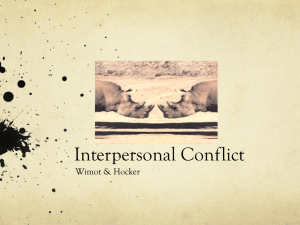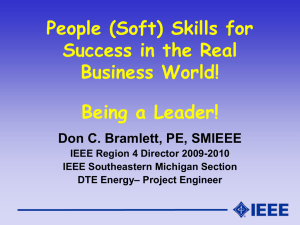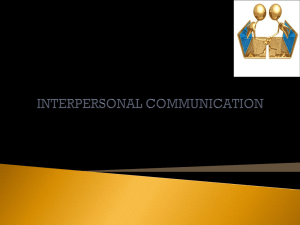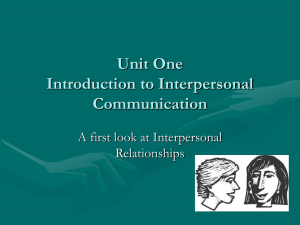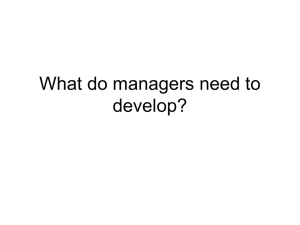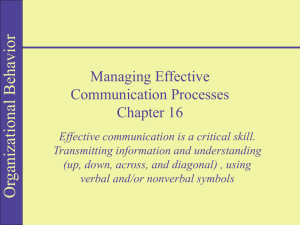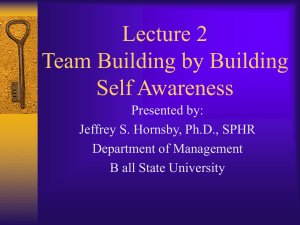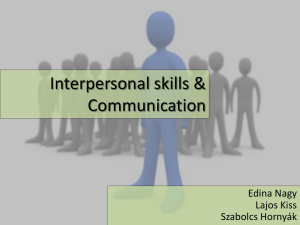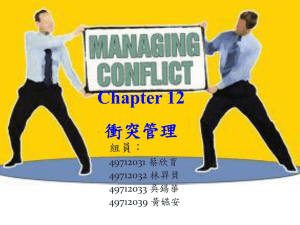CMM 420/520 SEC 201 Brammer/Bookwalter
advertisement
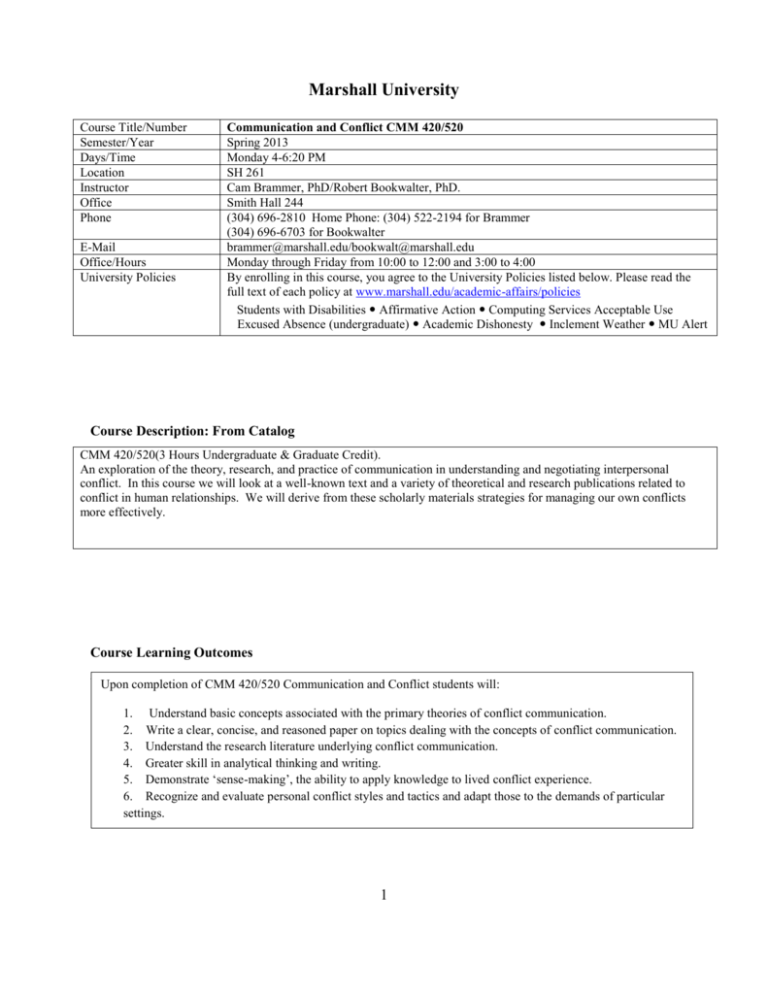
Marshall University Course Title/Number Semester/Year Days/Time Location Instructor Office Phone E-Mail Office/Hours University Policies Communication and Conflict CMM 420/520 Spring 2013 Monday 4-6:20 PM SH 261 Cam Brammer, PhD/Robert Bookwalter, PhD. Smith Hall 244 (304) 696-2810 Home Phone: (304) 522-2194 for Brammer (304) 696-6703 for Bookwalter brammer@marshall.edu/bookwalt@marshall.edu Monday through Friday from 10:00 to 12:00 and 3:00 to 4:00 By enrolling in this course, you agree to the University Policies listed below. Please read the full text of each policy at www.marshall.edu/academic-affairs/policies Students with Disabilities Affirmative Action Computing Services Acceptable Use Excused Absence (undergraduate) Academic Dishonesty Inclement Weather MU Alert Course Description: From Catalog CMM 420/520(3 Hours Undergraduate & Graduate Credit). An exploration of the theory, research, and practice of communication in understanding and negotiating interpersonal conflict. In this course we will look at a well-known text and a variety of theoretical and research publications related to conflict in human relationships. We will derive from these scholarly materials strategies for managing our own conflicts more effectively. Course Learning Outcomes Upon completion ofof CMM 420/520 Communication and Conflict students will: Upon completion CMM 420/520 Communication and Conflict students will: 1. 1. Understand basic concepts associated with thethe primary theories ofof conflict communication. Understand basic concepts associated with primary theories conflict communication. 2. 2. Write a clear, concise, and reasoned paper onon topics dealing with thethe concepts ofof conflict communication. Write a clear, concise, and reasoned paper topics dealing with concepts conflict communication. 3. 3. Understand thethe research literature underlying conflict communication. Understand research literature underlying conflict communication. 4. 4. Greater skill in in analytical thinking and writing. Greater skill analytical thinking and writing. 5. 5. Demonstrate ‘sense-making’, the ability to apply knowledge to to lived conflict experience Demonstrate ‘sense-making’, the ability to apply knowledge lived conflict experience. 6. Recognize and evaluate personal conflict styles and tactics and adapt those to the demands of particular settings. 1 Program Student Learning Outcomes for BA and MA Degrees: Upon completion of the BA or MA in Communication Studies students will: Oral Skills: 1. Students will demonstrate the ability to orally communicate competently. This includes the critical thinking skills necessary to compose, share, support, and defend (add/delete descriptors) messages that are appropriate to the unique audience being addressed, the type of speaking context in which the message is being shared (formal/informal; public/private), across speaking contexts (dyadic, group, organizational, or public). Written Skills: 2. Students will demonstrate the ability to communicate effectively in written documents. This includes the critial thinking skills necessary to compose, share, support, and defend (add/delete descriptors) documents that are appropriate to the unique audience being addressed, the type of speaking context in which the document is being shared. Theoretical Knowledge 3. Students will demonstrate knowledge of the primary theories within the field of Communication Studies. This includes demonstrating the ability to recognize, differentiate, and select appropriate theories/theoretical concepts to assess communication events and/or demonstrating the ability to analyze the appropriateness of others’ selection and use of theories/theoretical concepts. Research/Methodololgical Knowledge 4. Students will demonstrate knowledge of the research approaches commonly used to study human communication. This includes demonstrating the ability to recognize, differentiate and select the appropriate method to assess communication events and/or demonstrating the ability to analyze the appropriateness of others’ selection and use of methods. Degree Profile Outcomes 1. 2. 3. 4. 5. 6. 7. 8. 9. Knowledge: Specialized knowledge Broad Integrative Knowledge Intellectual Skills: Analytic Inquiry Intellectual Skills: Use of Information Resources Intellectual Skills: Engaging diverse perspectives Intellectual Skills: Quantitative fluency Intellectual Skills: Communication fluency Applied Learning Civic Learning 2 Relationships among Course, Program, and Degree Profile Outcomes Course Outcomes How Practiced in this Course How Evaluated in this Course Program Outcomes Understand basic concepts associated with the primary theories of conflict communication. Lecture, class activities, class discussion, readings 3,4 1,2,3,4,5,7,8 Write a clear, concise, and reasoned paper on topics dealing with the concepts of conflict communication. Lecture, class activities, class discussion, readings Class discussions and evaluation of written papers and experiential learning activities Class discussions and evaluation of written papers and experiential learning activities 2,3,4 1,2,3,4,5,7,8 Class discussions and evaluation of written papers and experiential learning activities Class discussions and evaluation of written papers and experiential learning activities Class discussions and evaluation of written papers and experiential learning activities Class discussions and evaluation of written papers and experiential learning activities 1,2,3,4 . Understand the research literature underlying conflict communication Lecture, class activities, class discussion, readings Greater skill in analytical thinking and writing Lecture, class activities, class discussion, readings Demonstrate ‘sensemaking’, the ability to apply knowledge to lived conflict experience Lecture, class activities, class discussion, readings Recognize and evaluate personal conflict styles and tactics and adapt those to the demands of particular settings. Lecture, class activities, class discussion, readings Degree Profile Outcomes 1,2,3,4 1,2,3,4,5,7,8 1,2,3, 4 1,2 1,2,3,4 1,2 Suggested Texts, Additional Reading, and Other Materials Wilmot, W. W. & Hocker, J. (2011). Interpersonal Conflict, 8th Edition. Dubuque, IA: W.C. Brown. ***Graduate Students see weekly readings. 3 Course Requirements 1. Case Cards. Each student will submit 5 cases, describing a personal or professional conflict. You will provide a brief description of the conflict with enough information to allow its use as a role playing prompt. (5 pts each: due Jan.28) 2. Process Notes. Much of our work in this course will be done through the use of case studies and role plays. Process notes are short (2 page) reaction/recommendation papers, related to a case study or role play from class. Each student will write 3 of these papers during the course of the semester. In these papers you will apply the text and/or supplemental reading concepts to an analysis of an in class role play. (25 pts each) 3. Conflict Self-Analysis. [Undergraduates Only] The first undergraduate paper is an analysis of your typical approach to conflict, your basic conflict management knowledge and skills, the goals you commonly advance and protect in conflicts, as well as your behavioral patterns related to power and conflict resolution. This analysis should reflect a reasonable familiarity with the readings during the first 6-7 weeks of the semester. (50 points; due Mar.11) 4. Structural Analysis of a Conflict. [Graduate Paper #1; Undergraduate Paper #2] This paper is a theory based analysis of a conflict in which you have been personally involved as a participant or as an intimate observer. You will discuss the structure and dynamics of the conflict and make grounded recommendations as to how the conflict might have been managed more productively. (Grad papers: 50 pts, due Mar.18 ; Undergrad papers: 50 pts, due Apr.15) 5. Graduate Research Paper focusing on an analysis of a conflict subtopic in which you are particularly interested. You will submit a paper proposal, with a 15-item bibliography on Apr.1(25 pts); a formal outline of the paper on Apr. 15 (25 pts); and the final paper on April 29 (100 pts). 6. Group Presentation. [Undergraduates Only] You will work with other undergraduate students in the class to prepare a demonstration of dysfunctional conflict processes and their theoretical and behavioral remedies. (50 pts; presented in class May 6) Grading Policy 90.00 – 100 80.00 – 89.00 70.00 – 79.00 60.00 – 69.00 Below 60.00 A B C D F Attendance Policy Students are expected to attend each class. Unexcused absences from two classes will result in a reduction of one letter grade for the semester; unexcused absences from four or more classes will result in an F. To obtain an excused absence, please go to the Dean of Students’ Office in the MSC. Attendance is required for all class sessions. Additional Policies: Students are responsible for any information or handouts that they miss during an absence. Please silence cell phones immediately upon entering class. DO NOT text or read texts during this class. Students are not to leave class to answer a phone call. If you feel the need to do so, please do not re-enter. This will be the only paper copy of the syllabus that will be distributed. Please hold on to it. 4 CMM 420/520 Tentative Course Schedule, Spring 2013 January 14 January 21 Introduction and Overview Martin Luther King Day Observance (No Class) January 28 Conflict Definitions & Frames Images of Conflict: Perceptions/Metaphors Culture & Gender Frames February 4 The Nature of Conflict: Sources & Elements Defining Conflict Destructive vs Constructive Conflict Fundamental Management Skills February 11 Issues & Goals in Conflict Multiple & Fluid Goals Clarifying Goals Chpt 3 February 18 Power: Uses & Abuses Definitions & Resources Balancing Power Chpt 4 February 25 Conflict Styles: Strategies & Tactics Understanding Conflict Styles Selecting Strategies Employing Tactics Chpt 5 March 4 Refining Conflict Strategies Matching Strategy to Goals Maximizing Productive Conflict Tactics March 11 Emotions in Conflict Positive & Negative Emotions Transforming Emotions SPRING BREAK Chpt 6 Undergrad Paper 1 Due March 25 Assessing Conflicts Mapping Conflict Rules & Patterns Conflict Assessment Guides Chpt 7 Graduate Paper 1 Due April 1 Negotiation & Bargaining Informal Bargaining Negotiation Strategies Chpt 8 Graduate Proposals Due April 8 Formal Conflict Contexts Negotiation Skills Two Dimensions of Negotiation March 17-24 April 15 Third Party Intervention Third Party Roles The Intervention Process Case Cards Due Chpt 2 Chpt 9 Grad Outlines Due Undergrad Paper 2 Due April 22 Third Party Intervention, continued April 29 Transcending Transgression Forgiveness Reconciliation May 6 Chpt 1 Chpt 10 Graduate Final Paper Due Final Presentations (Undergrad Groups) 5 CMM 520: Communication & Conflict Graduate Weekly Readings January 14 Introduction and Overview January 28 Conflict Definitions & Frames Images of Conflict: Perceptions/Metaphors Culture & Gender Frames *Hocker & Wilmot, Chapter 1 Apfelbaum, E. (1974). On conflicts and bargaining. In L Berkowitz, (Ed.), Advances in Experimental Social Psychology, 7, 103-156. Argyle, M. & Furnham, A. (1983). Sources of satisfaction and conflict in long term relationships. Journal of Marriage and the Family, 45, 418-493. Bell, M.A. (1983). A research note: The relationship of conflict and linguistic diversity in small groups. CSSJ, 34:2, 128-133. Brewer, M.B. (1986). The Role of ethnocentrism in intergroup conflict. In S. Worchel & W.G. Austin, Psychology of Intergroup Relations, 88-102. Kennedy, K.A. & Pronin, E. (2008). When disagreement gets ugly: Perceptions of bias and the escalation of conflict. Personality and Social Psychology Bulletin, 34, 833-848. Kowalski, R., Walker, S., Wilkenson,R., Queen,nA. & Sharpe, B. (2003). Lying, cheating, complaining, and other aversive interpersonal behaviors: A narrative examination of the darker side of relationships. Journal of Social and Personal Relationships, 20, 471-490. Koerner, A. & Fitzpatrick, M.A. (1997). Family type and conflict: The impact of conversation orientation and conformity orientation on conflict in the family. CS, 48:1, 59-75. Putnam, L. & Folger, J. (1988). Communication, conflict, and dispute resolution: The study of interaction and the development of conflict theory. Communication Research, 15:4, 349-359. *Watkins, C.E. (1974). An analytical model of conflict. CM, 41:1, 1-5. February 4 The Nature of Conflict: Sources & Elements Defining Conflict Destructive vs Constructive Conflict Fundamental Management Skills *Hocker & Wilmot, Chapter 2 Brinson, S.L. & Winn, J.E. (1997). Talk shows’ representations of interpersonal conflicts. Journal of Broadcasting and Electronic Media, 41:1, 25-39. Canary, D. Cunningham, E.M., & Cody, M. (1988). Goal types, gender, and locus of control in managing interpersonal conflict. CR, 15:4, 426-446. Carrocci, N. (1985). Perceiving and responding to interpersonal conflict. CSSJ, 36:4, 215-228. Deutsch, M. (1971). Toward an understanding of conflict. International Journal of Group Tensions, 1, 42-54. McCorkle, S. & Mills, S. (1992). Rowboat in a hurricane: Metaphors of interpersonal conflict management. Communication Reports, 5:2, 57-66. Saine, T. (1974). Perceiving communication conflict. CM, 41:1, 49-56. Schmidt, S.M. & Kochan, T.A. (1972). Conflict: Toward conceptual clarity. Administrative Science Quarterly, 17, 359-370. Steinfatt,, T.M. (1974). Communication & conflict: A review of new material. HCR, 1:1, 81-89. *Tannen, D. (1998). Fighting for our lives (Chapter 1). In D. Tannen, The argument culture: Moving from debate to dialogue. New York: Random House. 3-26. 6 February 11 Issues & Goals in Conflict Multiple & Fluid Goals Clarifying Goals *Hocker & Wilmot, Chapter 3 Alderton, S.M. (1982). Locus of control-based argumentation as a predictor of group polarization. CQ, 30:4, 381-387. Donohue, W., Weider-Hatfield, D. Hamilton, M, & Diez, J. (1985). Relational distance in managing conflict. HCR, 11:3, 387-405. Jacobs, S. & Jackson, S. (1981). Argument as a natural category: The routine grounds for arguing in conversation. WJSC, 45:2, 118-132. Lakey, S.G. & Canary,D.J. (2002). Actor goal achievement and sensitivity to partner as critical factors in understanding interpersonal communication competence and conflict strategies. CM, 69, 217-235. Rogan, R.G. & LaFrance, B.H. (2003). An examination of the relationship between verbal aggressiveness, conflict management strategies, and conflict interaction goals, CQ, 51, 458-469. Sillars, A. & Parry, D. (1982). Stress, cognition, and communication in interpersonal conflicts. CR, 9:2, 201-226. *Waln, V.G. (1982). Interpersonal conflict interaction: An examination of verbal defense of self. CSSJ, 33:4, 557-566. February 18 Power: Uses & Abuses Definitions & Resources Balancing Power *Hocker & Wilmot, Chapter 4 Babcock, J.C., Waltz, J., Jacobson, N.S. & Gottman, J.M. (1993). Power and violence: The relation between communication patterns, power discrepancies, and domestic violence. Journal of Consulting and Clinical Psychology, 61, 40-50. *Boster, F.J. & Kazoleas, D. (1995). The impact of power on communicative persistence, strategic diversity and bargaining outcomes. Communication Reports, 8:2, p136+. Conrad, C. (1983). Power and performance as correlates of supervisors’ choice of modes of managing conflict: A preliminary investigation. WJSC, 47:3, 218-228. Dunbar, N.E. & Abra, G. (2010). Observations of power and interactional dominance in interpersonal relationships. Journal of Social and Personal Relationships, 22, 207-233. Kipnis, D. (1976). The metamorphic effects of power. In The Powerholders. Chicago: University of Chicago Press. Young, D.M., Korner, K.M., Gill, J.D. & Beier, E.G. (1977). “Beneficial” aggression. JoC 27:3, 100-103. Raven, B.H. & Kruglanski, A.W. (1970). Conflict and power. In P. Swingel, ed., The Structure of Conflict. New York: Academic Press, 69-109. Richmond, V., Wagner, J.P. & McCroskey, J. (1983). The impact of perceptions of leadership style, use of power, and conflict management style on organizational outcomes. CQ, 31:1, 27-36. Skill, T. & Wallace, S. (1990). Family interactions on primetime television: A descriptive analysis of assertive power interaction. Journal of Broadcasting and Electronic Media, 34:3, 243-262. February 25 Conflict Styles: Strategies & Tactics Understanding Conflict Styles Selecting Strategies & Employing Tactics *Hocker & Wilmot, Chapter 5 Cai, D.A. & Fink, E.L. (2002). Conflict style differences between individualists and collectivists. CM, 69, 67-87. Jourdain, K. (2004). Communication styles and conflict. The Journal for Quality and Participation, 27:2, 23-25. McKinney, B.C. & Kelly, L. (1997). The relationship between conflict message styles and dimensions of 7 communication competence. Communication Reports 10:2, p 185+ Wheeless, L.R. & Reichel, L.S. (1990). A reinforcement model of the relationships of supervisors’ general communication styles and conflict management styles to task attraction. CQ, 38:4, 372-402. Canary, D.J. & Spitzberg, B. (1989). A model of the perceived competence of conflict strategies. HCR, 15:4, 630-649. *Fitzpatrick, M.A. & Winke, J. (1979). You always hurt the one you love: Strategies and tactics in interpersonal conflict. CQ, 27:1, 3-11. Newton, D. & Burgoon, J. (1990). The use and consequences of verbal influence strategies during interpersonal disagreements. HCR, 16:4, 477-518. Sereno, K., Welch, M., & Bratten, D. (1987). Interpersonal conflict: Effects of variations in manner of expressing anger and justification for anger upon perceptions of appropriateness, competence and satisfaction. Journal of Applied Communication Research, 15:1/2, 128-143. Sillars, A., Coletti, S. Parry, D. & Rogers, M. (1982). Coding verbal conflict tactics: Nonverbal and perceptual correlates of the “avoidance-distributive-integrative” distinction. HCR, 9:1, 83-95. *Witteman, H. (1992). Analyzing Interpersonal Conflict: Nature of awareness, type of initiating event, situational perceptions and management styles. WJSC, 56, 248-280. March 4 Refining Conflict Strategies Matching Strategy to Goals Maximizing Productive Conflict Tactics Canary, D.J. & Spitzberg, B. (1987). Appropriateness and effectiveness perceptions of conflict strategies. HCR, 14:1, 93-118. *Infante, D., Sabourin, T.C., Rudd, J.E., and Shannon, E. (1990). Verbal aggression in violent and nonviolent marital disputes. CQ, 38:4, 361-371. Jackson, S. & Jacobs, S. (1981). The collaborative production of proposals in conversational argument and persuasion: A study of disagreement regulation. A&A, 18:23, 77-90. Johnson, D., McCarty, K. & Allen, T. (1976). Congruent and contradictory verbal and nonverbal communications of cooperativeness and competitiveness in negotiations. CR, 3:3, 275-292. Miller, C.W. & Rolloff, M.E. (2006). The perceived characteristics of irresolvable, resolvable and resolved intimate conflicts: Is her evidence of intractability? International Journal of Conflict Management, 17, 291-315. Olson, L. & Baithwaite, D. (2004). "If you hit me again, I'll hit you back." Conflict management strategies of individuals experiencing aggression during conflicts. CS, 55, 271-285. Papa, M. & Pood, E. (1988). Coorientational accuracy and organizational conflict: An examination of tactic selection and discussion satisfaction. CR, 15:1, 3-28. Trapp, R. (1989). Interpersonal argumentation: Conflict and reason-giving. Communication Reports, 2:2, 105-109. Wieder-Hatfield, D. & Hatfield, J.D. (1996). Superiors’ conflict management strategies and subordinate outcomes. Management Communication Quarterly, 10:2, 189-208. March 11 Emotions & Conflict Transforming Negative Emotions to Positive Effects *Hocker & Wilmot, Chapter 6 Bell, C. & Song, F. (2005). Emotions in the conflict process: An application of the cognitive appraismodel of emotions to conflict management. International Journal of Conflict Management, 16:1, 111-131. Canary, D.J., Spitzberg, B.H. & Semic, B.A. (1998). The experience and expression of anger in interpersonal settings. In P.A. Andersen & L.K. Guerrero (Eds.), Handbook of communication and emotion: Research, theory, and contexts (pp. 191-213). New York: Academic Press. Carsterson, ll, Gottman, J.M., & Levenson, R.W. (2004). Emotional behavior in long-term marriage. In Close relationships: Key readings, Reis, H.T., & Rusbult, C.E. (Eds.), Philadelphia: Taylor & Francis 457470. Guerrero, L.K. & La Valley, A.G. (2006). Conflict emotion and communication. In The Sage handbook of 8 conflict communication, Oetzel, J.G. & Ting-Toomey, W. (Eds.) Thousand Oaks, CA: Sage Publications, 69-96. Rivers, S.E., Brackett, M.A., Katulak, N.A., & Salovey, P. (2006) Regulating anger and sadness: An exploration of discreet emotions in emotion regulation. Journal of Happiness Studies, 8, 393-427. Sanford, K. (2007). Hard and soft emotions during conflict: Investigating married couples and other relationships. Personal Relationships, 14, 65-90. Yoshimura, S. (2007). Goals and emotional outcomes of revenge activities in interpersonal relationships. Journal of Social and Personal Relationships, 24:1, 87-98. March 25 Assessing the Structure of Conflict Conflict Patterns & Assessment Guides *Hocker & Wilmot, Chapter 7 Papp, L.M., Cummings, E.M., & Goeke-Morey, M.C. (2002). Marital conflicts in the home when children are present versus absent. Developmental Psychology, 38:5, 774(10). Deutsch, M. (1973). Conflicts: Productive and destructive. In F. Jandt, (Ed.) Conflict Resolution through Communication, New York: Harper and Row. Papp, L.M., Kouros, C.D. & Cummings, E.M. (2009). Demand-withdraw patterns in marital conflict in the home. Personal Relationships, 16, 285-300. Sillars, A.L., Smith, T. & Koerner, A. (2010). Misattributions contributing to empathic (in)accuracy during parent-adolescent conflict discussions. Journal of Social and Personal Relationships, 27, 727-748. Turk, D.R. & Monahan, J.L. (1999). "Here I go again": An examination of repetitive behaviors during interpersonal conflicts. Southern Communication Journal, 64, 232-244. *Wehr, P. (1979). Self-limiting conflict [Chapter 3]. In P. Wehr, Conflict Regulation, Boulder, CO: Westview Press. Winstok, Z., Eisikovits, Z & Gelles, R. (2002). Structure and dynamics of escalation from the batterers perspective. Families in Society, 83, 129-141. Yelsma, P. (1984). Functional conflict management in effective marital adjustment. CQ, 32:2, 56-61. April 1 Negotiation & Bargaining Informal Bargaining & Negotiation Strategies *Hocker & Wilmot, Chapter 8 Fisher, R. & Davis, W. (1987). Six basic interpersonal skills for a negotiator’s repertoire. Negotiation Journal, 3, 117-125 Jackson, S. & Jacobs, S. (1981). The collaborative production of proposals in conversational argument and persuasion: A study of disagreement regulation. Journal of the American Forensic Association, 18:2, 7790. Rogan, R. & Hammer, M.R. (1994). Crisis negotiations: A preliminary investigation of facework in naturalistic conflict discourse. Journal of Applied Communication Research, 22:3, 216-231. Schelling, T. (1960). Randomization of threats and promises & the threat that leaves something to chance. In T. Schelling, The Strategy of Conflict, London: Oxford Press. Schultz, B. (1982). Argumentativeness: Its effect in group decision-making and its role in leadership perception. CE, 30:4, 368-375. April 8 Formal Conflict Contexts Negotiation Skills Two Dimensions of Negotiation *Donohue, W.A. (1981). Development of a model of rule use in negotiation interaction. CM, 48, 106-120. O’Connor, K.M. & Carnevale, P.J. (1997). A nasty but effective negotiation strategy: Misrepresentation of a common value issue. Personality & Social Psychology Bulletin, 23:5, 504+. *Putnam, L. & Geist, P. (1985). Argument in bargaining: An analysis of the reasoning process. SCJ, 50:3, 225-245. Schelling, T. (1976). An essay on bargaining. In T. Schelling, The Strategy of Conflict, London: Oxford Press. 9 April 15 Third Party Intervention Third Party Roles & The Intervention Process *Hocker & Wilmot, Chapter 9 *Donohue, W.A., Allen, M. & Burrell, N. (1988). Mediator communication competence. CM, 55:1, 104119. Jones, T.S. (1988). Phase structures in agreement and no-agreement mediation. CR, 15:4, 470-495. Ma, R. (1992). The role of unofficial intermediaries in intersersonal conflicts in the Chinese culture. CQ, 40:3, 269-278. Womack, D.F. (1985). The role of argument in mediation styles. A&A, 21:4, 215-225. Graduate Paper Outlines Due April 22 Third Party Intervention (continued) Mediation of Disputes *Keltner, J.W. (1987). Practice. In J.W. Keltner, Mediation: Toward a civilized system of dispute resolution. Annandale, VA: SCA Publications. Sherwood, J. & Glidewell, J. (1980). Planned renegotiation: A normsetting of intervention. In B. Morse & L. Phelps, Interpersonal communication: A relational perspective. Minneapolis, MN: Burgess. Walker, G.B. (1990). Argumentation and the mediation process. Paper presented to the Speech Communication Association annual convention, Chicago, IL Wehr, P. (1979). Conflict regulation: Methods and techniques. In P. Wehr, Conflict Regulation, Boulder, CO: Westview Press. April 29 Transcending Transgression Forgiveness & Reconciliation Enright, R., Gassin, E., & Wu, C. (1992). Forgiveness: A developmental view. Journal of Moral Education, 21:101. Fehr, R. & Gelfand, J.J. (2010). When apologies work: How matching apology components to victims' selfconstruals facilitates forgiveness. Organizational Behavior and Human Decision Processes, 113, 37-50. Kelley, D. (1998). The communication of forgiveness. CS, 49:255-271. *Kelley, D. & Waldron, V. (2005). An investigation of forgiveness-seeking communication and relational outcomes. CQ, 53:3, 339-358. Roloff, M. & Cloven, D.H. (1994). When partners transgress: Maintaining violated relationships. In D.J. Canary & L. Stafford (Eds.), Communication & Relational Maintenance, NY:Academic Press, 23-43. Wilmot, W.W. (1994). Relational rejuvenation. In D.J. Canary & L. Stafford (Eds.), Communication & Relational Maintenance, NY:Academic Press, 255-273. Graduate Final Papers Due May 6 Final Presentations Graduate Reading List Key to Journal Abbreviations: A&A = Argument & Advocacy (formerly Journal of the American Forensic Association) CE = Communication Education (formerly The Speech Teacher) CM = Communication Monographs CQ = Communication Quarterly CR = Communication Research CS = Communication Studies (formerly Central States Speech Journal) CSSJ = Central States Speech Journal 10 HCR = Human Communication Research JoACR = Journal of Applied Communication Research JoC = Journal of Communication QJS = Quarterly Journal of Speech SCJ = Southern Communication Journal WJC = Western Journal of Communication (formerly Western Journal of Speech Communication) WJSC = Western Journal of Speech Communication 11 12
